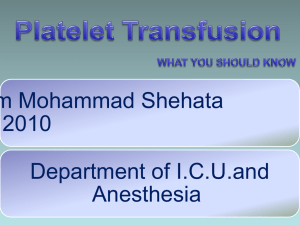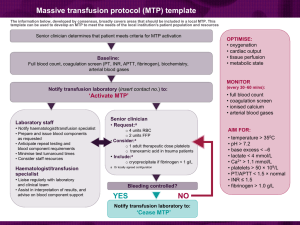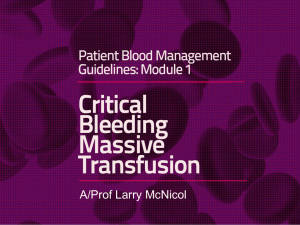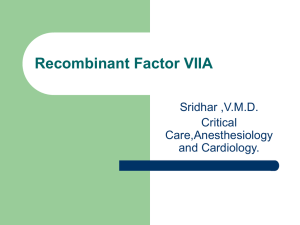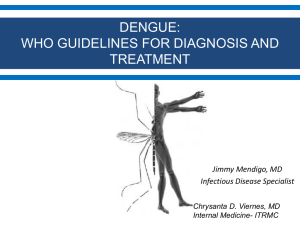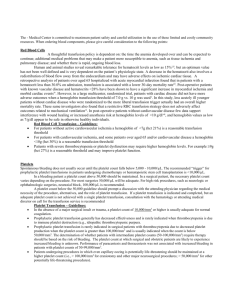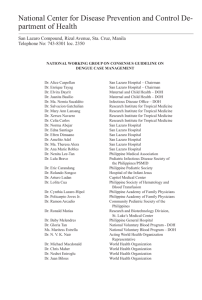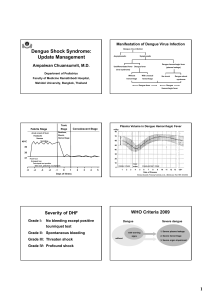DV-ab
advertisement
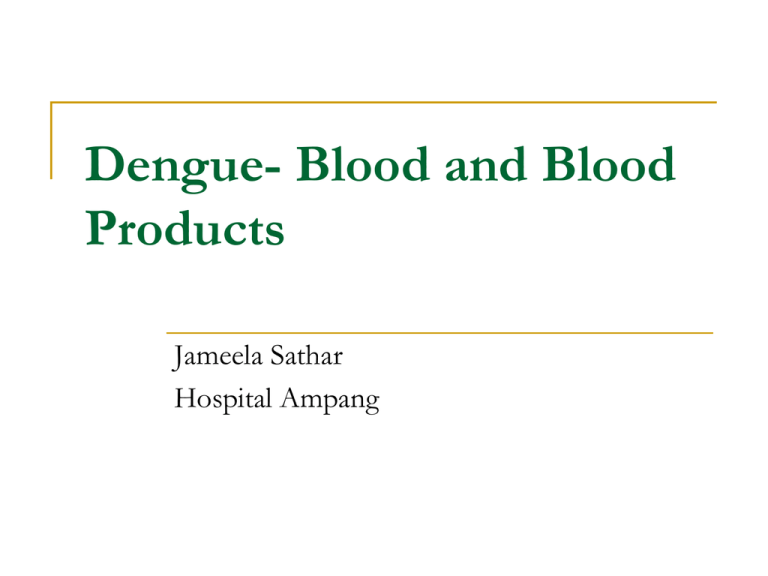
Dengue- Blood and Blood Products Jameela Sathar Hospital Ampang Haemostatic Changes in Dengue 1. Vasculopathy/ Endothelial activation - Hess’s test is an early sign - Plasma leakage 2. Thrombocytopenia 3. Coagulation abnormalities Mitrakul C 1987 Endothelial activation lumen DV-ab C DV-ab C C C IL IL IL EC C Complement: C3a, C5a-C9 IL Interleukin Dengue-infected monocytes Plasma leak Raised haematocrit Early evidence of plasma leakage Platelet activation lumen DV-ab DV-ab Plt Plt Plt endothelium Plt vWF Thrombocytopenia Platelet count begins to fall towards the end of febrile stage Lowest during leakage phase Main mechanism: platelet activation Coagulation activation lumen DV-ab DV-ab T T Plt Plt T thrombin fibrinogen T Plt VIIa vWF TF Coagulation Abnormalities Prolonged APTT: 54.6% Prolonged PT: 33.3% Variable but no significant reduction in coagulation factors II, V, VII, VIII, IX, XII and X These do not mean that patient has DIC! Other factors: ? Contact factor deficiency or presence of inhibitor Isarangkura PB 1987 Coagulation Abnormalities In general, only mild and improves after fluid replacement or cease spontaneously after recovery of illness However prolonged shock can lead to acidosis and DIC resulting in occult or overt bleeding and end-organ damage Thrombocytopenia and coagulation abnormalities do not reliably predict bleeding in dengue infection Chaudhary R 2006; Mairahu AT 2003; Krishnamurti C 2001; Coagulation Abnormalities 48 children with DSS in Vietnam: Reduced levels of anticoagulant proteins: PC, PS, AT Due to plasma leakage and loss Increased levels of: Thrombomodulin Tissue factor PAI-1 Due to endothelial activation Wills 2002 Coagulation Abnormalities Prospective cohort study 42 Thai children with dengue (20 DF; 22 DHF) Endothelial cell activation assays were higher in DHF thrombomodulin t-PA TF ADAMTS Abnormal vWF multimers were only seen in DHF patients Sosothikul 2007 Increased markers of endothelial activation may promote microvascular thrombosis and end-organ damage Esmon CT 2004 Use blood and blood products with caution and only when indicated Management of bleeding in dengue Mild bleeding eg. gums, vagina, epistaxis or petechiae usually cease spontaneously and do not require blood or platelet transfusion Transfusion of blood and/or blood products in dengue is indicated only when there is evidence of significant bleeding (occult or overt) WHO 1997 Significant occult bleeding Haematocrit not as high as expected for the degree of shock to be explained by plasma leakage alone A drop in HCT without clinical improvement despite adequate fluid replacement (40-60 ml/kg) Severe metabolic acidosis and end-organ dysfunction despite adequate fluid replacement Lum LC 2002 Significant bleeding- which blood products? Blood transfusion with whole blood or packed cell (preferably less than 1 week old) ± blood products if in DIC or uncontrolled bleeding Management of UGIT bleed Endoscopy and endoscopic injection therapy in upper GIT haemorrhage increases the risk of bleeding and should be avoided Blood transfusion if significant bleeding Chiu YC 2005 What are the risk factors for significant bleeding? Risk factors for hemorrhage in severe dengue Lum et al, J Ped 2002 Clinical /laboratory parameter Group 1 (significant hemorrhage) (n=22) Group 2 (no/mild hemorrhage) (n=92) P value Age (mean) (years) 6.1 + 4.0 5.9 + 3.5 0.8 Male : Female ratio 1:1 1:0.9 0.9 Platelet count (x 109/L) 72 + 54 71 + 50 0.9 Lowest platelet count 23 + 18 28 + 21 0.4 Serum sodium (mmol/L) 127 + 6 130 + 6 0.49 Risk factors for hemorrhage in severe dengue Clinical/Laboratory features Odd ratio 95% CI b P value Encephalopathy 0.01 0.00-41.89 -4.40 0.289 Mottling 0.08 0.00-15.50 -2.50 0.350 Hypotension 2.28 0.18-28.19 0.08 0.521 Duration of shock 2.11 1.13-3.92 0.75 0.019 HCT at admission Liver failure Renal failure at adm Prothrombin time ratio Abnormal glycemia Partial thromboplastin time 0.72 1.8x104 1.44 0.10 2.71 1.03 0.55-0.95 0.50-6.80x108 0.10-249.90 0.00-46.89 0.22-33.68 0.98-1.07 -0.33 9.83 0.37 -2.30 1.00 0.03 0.020 0.067 0.889 0.454 0.437 0.262 Lum et al, J Ped 2002 Results Bleeding is not related to degree of thrombocytopenia Bleeding is related to the duration of shock due to plasma leakage Lum et al, J Ped 2002 Prevention of hemorrhage in DHF Early recognition of shock Prompt correction of shock to prevent acidosis which leads to bleeding Preventive transfusions in DSS – is it necessary? Lum et al, J Ped, 2003 Clinical parameter* Treatment groups# Received bld prod (n=60) Did not receive bld prod (n=46) P value Duration of shock (hours) 4.0 4.0 0.918 % increase in hematocrit 53.0 42.0 0.239 Lowest platelet count (x 109/L) 20.5 22.0 0.127 Highest PTR 1.2 1.1 0.207 Highest PTT (sec) 77.7 71.3 0.347 FFP transfused (ml/kg) 20.0 0 0.000 Total platelets transfused (units/kg) 0.2 0 0.000 Total fluid balance (ml/kg) 121.0 107.0 0.045 Days of thrombocytopenia 5.0 4.0 0.395 Days of hospitalization 7.0 5.0 0.000 ^Incidence (%)of bleeding 60.0 43.5 0.136 Incidence (%)of pulmonary edema 30.0 6.5 0.006 Behaviour of transfused platelets in DSS Mean % change in platelet count after transfusion 400 Patient no =52 No of transfusions=113 300 200 100 0 0 1 2 3 4 5 6 7 8 9 10 11 12 Time (hours) after transfusion LCS Lum et al, 2003 Life-threatening complications of blood/ blood products Bacterial contamination TRALI: Transfusionrelated acute lung injury TTI: Transfusiontransmitted infections Wrong blood Infective risks of blood/ blood products Virus Units transfused HIV 1:500,000 HCV 1:150,000 HBV 1: 50,000 (prior to NAT testing) There is no role for prophylactic transfusion with platelets and fresh frozen plasma in dengue patients No role for prophylactic transfusion of platelets or FFP Do not produce sustained changes in the coagulation status and platelet count in patients with DHF/DSS Do not change or reduce the bleeding outcome in DHF Inappropriate transfusion of blood products increases the risk of pulmonary oedema and respiratory embarrassment Adjunctive therapy Insufficient evidence to support use in dengue of Recombinant activated factor VII (rFVIIa) in significant bleeding ivIG Steroids The coagulation system is activated in dengue and infusion of activated factor concentrates may increase the risk of thrombosis Summary The process of coagulation and platelet activation is an intrinsic part of the disease Significant bleeding occurs following prolonged shock and acidosis It is important to recognise and correct hypovolemia to prevent shock which leads to acidosis and DIC/bleeding Summary There is evidence that prophylactic platelet transfusion is not useful There is no role for FFP as a plasma expander Blood transfusion is indicated if there is evidence of significant bleeding Pitfalls in the management of DHF Focus on platelet count instead of hematocrit Too much focus on bleeding instead of plasma leakage Too much emphasis on lab results rather than the clinical condition of the patient Late recognition of shock and inadequate resuscitation Pitfalls in the management of DHF Not recognising that Hct does not drop to low levels even in significant bleed Transfusion of blood only when the Hct falls to a low level may be too late Too much reliance on platelet and FFP transfusion to control bleeding Inappropriate and unnecessary transfusion of platelets and FFP will lead to fluid overload Thank You

